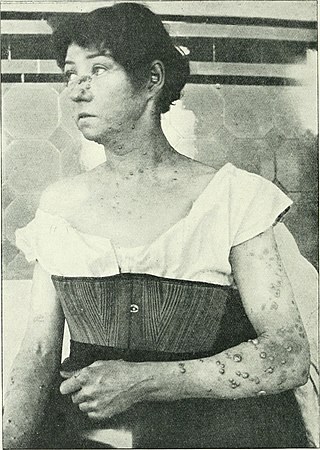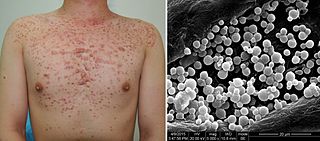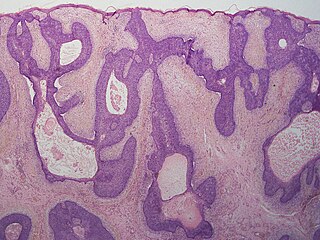| Follicular atrophoderma | |
|---|---|
| Specialty | Dermatology |
Follicular atrophoderma is a skin condition consisting of follicular indentations without hairs, notably occurring on extensor surfaces of the hands, legs and arms. [1]
| Follicular atrophoderma | |
|---|---|
| Specialty | Dermatology |
Follicular atrophoderma is a skin condition consisting of follicular indentations without hairs, notably occurring on extensor surfaces of the hands, legs and arms. [1]

A seborrheic keratosis is a non-cancerous (benign) skin tumour that originates from cells, namely keratinocytes, in the outer layer of the skin called the epidermis. Like liver spots, seborrheic keratoses are seen more often as people age.

Hyperkeratosis is thickening of the stratum corneum, often associated with the presence of an abnormal quantity of keratin, and is usually accompanied by an increase in the granular layer. As the corneum layer normally varies greatly in thickness in different sites, some experience is needed to assess minor degrees of hyperkeratosis.
The arrector pili muscles, also known as hair erector muscles, are small muscles attached to hair follicles in mammals. Contraction of these muscles causes the hairs to stand on end, known colloquially as goose bumps (piloerection).
Lichen spinulosus is a rare skin disorder characterized by follicular keratotic papules that are grouped into large patches. It is a variant of keratosis pilaris named for its resemblance to a patch of lichen.
Central centrifugal cicatricial alopecia (CCCA), is a type of alopecia first noticed in African Americans in the 1950s and reported by LoPresti et al. in 1968 as a result of application of petrolatum followed by a stove-heated iron comb. The original theory was that the hot petrolatum would travel down to the hair root, burn the follicle, and after repetitive injury scarring would result. Later CCCA was realized to affect men and women without a history significant for use of such styling techniques. Consequently, the terms "follicular degeneration syndrome" per Sperling and Sau in 1992 and then CCCA per Olsent et al. in 2003 were evolved. Plausible contributing factors may include other African-American styling techniques such as relaxers, tight braids, heavy extensions, certain oils, gels or pomades.
Tufted folliculitis presents with doll's hair-like bundling of follicular units, and is seen in a wide range of scarring conditions including chronic staphylococcal infection, chronic lupus erythematosus, lichen planopilaris, Graham-Little syndrome, folliculitis decalvans, acne keloidalis nuchae, immunobullous disorders, and dissecting cellulitis.
Keratosis pilaris atrophicans faciei begins in infancy as follicular papules with perifollicular erythema. Initially, the lesions are restricted to the lateral eyebrows, but with time spread to involve the cheeks and forehead, and may also be associated with keratosis pilaris on the extremities and buttocks.
Atrophodermia vermiculata presents with erythematous follicular papules on the cheeks in childhood and, with time, the lesions develop into pit-like depressions.
Traumatic anserine folliculosis is a curious gooseflesh-like follicular hyperkeratosis that may result from persistent pressure and lateral friction of one skin surface against another. Traumatic anserine folliculosis is caused by trauma. Topical keratolytics are the treatment of choice.
Trichostasis spinulosa is a common but rarely diagnosed disorder of the hair follicles that clinically gives the impression of blackheads, but the follicles are filled with funnel-shaped, horny plugs that are bundles of vellus hairs.
Alopecia mucinosa, also known as Follicular mucinosis, Mucinosis follicularis, Pinkus' follicular mucinosis, and Pinkus' follicular mucinosis–benign primary form, is a skin disorder that generally presents, but not exclusively, as erythematous plaques or flat patches without hair primarily on the scalp, neck and face. This can also be present on the body as a follicular mucinosis and may represent a systemic disease.

Iododermas are caused by iodides, with the most common sources of exposure being oral and intravenous contrast materials used to treat thyroid disease. The most common type of eruption is an acneiform eruption with numerous acutely inflamed follicular pustules, each surrounded by a ring of hyperemia.

Warty dyskeratoma, also known as an Isolated dyskeratosis follicularis, is a benign epidermal proliferation with distinctive histologic findings that may mimic invasive squamous cell carcinoma and commonly manifests as an umbilicated lesion with a keratotic plug, WD have some histopathologic similarities to viral warts but it's not caused by HPV and the majority of these lesions display overall histopathologic features consistent with a follicular adnexal neoplasm. Usually limited to the head, neck, scalp or face and vulva. Lesions are generally solitary and sporadic and may be associated with a follicular unit. Oral involvement, particularly the hard palate, and genital involvement have been reported. it can also be thought of as one of the manifestations of focal acantholytic dyskeratosis, an epidermal reaction pattern that can be seen in several disorders, including Darier's disease and Grover's disease. But the main Difference between Darier disease and Warty dyskeratoma, is that Darier disease inherited dermatosis consisting of multiple keratotic papules on the face, trunk, and extremities, while WD occurs as an isolated, noninherited, single keratotic nodule mainly confined to the head and neck as mentioned earlier.

Malassezia folliculitis or Pityrosporum folliculitis, is a skin condition caused by infection by Malassezia yeast.
Superficial pustular folliculitis is a superficial folliculitis with thin-walled pustules at the follicular openings.

Sycosis vulgaris is a cutaneous condition characterized by a chronic infection of the chin or bearded region.
Post-vaccination follicular eruption is a cutaneous condition that occurs 9 to 11 days following vaccination, and is characterized in multiple follicular, erythematous papules.

Basaloid follicular hamartoma is a cutaneous condition characterized as distinctive benign adnexal tumor that has several described variants. It manifest as small tan or brown coloured papules in the trunk, pubic area, face, scalp, and axilla.

Tumor of follicular infundibulum, also known as infundibuloma, and isthmicoma is a cutaneous condition characterized by flat, keratotic papules of the head and neck, skin lesions that are usually solitary.

Proliferating trichilemmal cysts, also known as a pilar tumor, proliferating follicular cystic neoplasm, proliferating pilar tumor, and proliferating trichilemmal tumor is a cutaneous condition characterized by proliferations of squamous cells forming scroll-like structures.